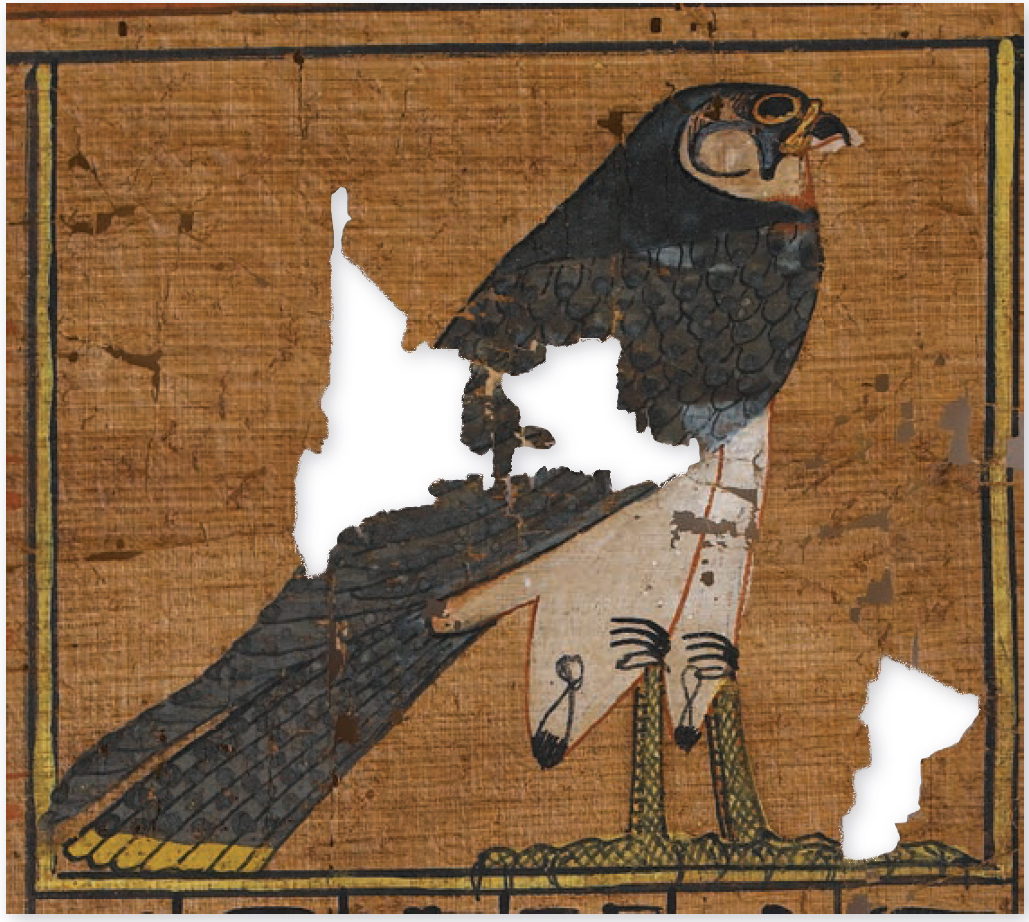
The falcon, seen here on a papyrus from Ramose’s Book of the Dead, represents the god Sokar, symbolic of royal rebirth and confirmation of regal power. The head pattern suggests that this is Barbary Falcon, a close relative of Peregrine.
3 : Papyrus bird painting
c. 3,300 BP

The falcon, seen here on a papyrus from Ramose’s Book of the Dead, represents the god Sokar, symbolic of royal rebirth and confirmation of regal power. The head pattern suggests that this is Barbary Falcon, a close relative of Peregrine.
Ancient Egyptian depictions of birds did not remain on the rock face but moved to the tomb wall, and commonly appeared on papyri, a material similar to modern paper, and used in much the same way for drawing, painting and writing.
True papyrus is made from the stems of the shallow water sedge Cyperus papyrus, which grows at the edge of rivers and lakes, and began being manufactured in the Nile Valley about 5,000 years ago. The plant grows rapidly and extensively, and formed harvestable swamps on the Nile’s floodplain, its use enabling an explosion of written and illustrated communication during the growth of ancient Egyptian civilisation. In fact, much of Egyptian society also relied upon the rich biota of the papyrus stands, which provided birds and mammals for hunting, and formed breeding grounds for a profusion of edible fish; the Nile itself deposited the highly productive soils of the region. It is thought that the later decline of the Egyptian Empire could be indirectly attributed to over-exploitation of these fecund resources.
The papyrus sedge also represents the retreat of a particular habitat back into the ‘Dark Continent’. The plants are relied upon by several species of heron, warbler and weaver, many of which are still found in Egypt, but in different proportions as the specialist habitat is now very scarce. It is likely that more southern African species may have lived to the north of their current range in Egypt when the swamps were at their full extent.
Gradually, the Nile was changed by the conflicting and exploitative usage of humans. It became embanked, diverted for irrigation and its floodplain was drained and substantially dried out. Papyrus vanished from much of its former range and many of the examples which can be seen in Egypt now are derived from reintroduced stock.
In another thread through history, the papyrus sedge has been moved around the world as an exotic ornamental plant, escaping into the wild in Hawai’i, California, Louisiana and Florida, where it has become an invasive alien, dominating many native species.
Around 2,000 years ago, papyrus began to be superseded by parchment, a more robust form of writing substrate made from prepared animal skins; these were able to be bound into forms recognisable as books, aiding their repeated use and storage. Few papyri or the scrolls into which they were compiled survive in legible form today, as they were easily compromised by both humidity and dryness, as well as being rough to write and draw on, limiting their use.
Papyrus has a basal role in the history of ornithological publishing, being the original source of printed and written media as we know them. The actual reproduction of writing in the form of printing would have to wait for another 1,400 years, however.